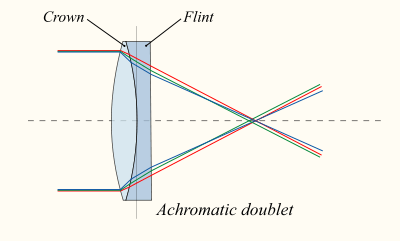Crown glass (optics)
Crown glass is a type of optical glass used in lenses and other optical components. It has relatively low refractive index (≈1.52) and low dispersion (with Abbe numbers around 60). Crown glass is produced from alkali-lime (RCH) silicates containing approximately 10% potassium oxide and is one of the earliest low dispersion glasses.
As well as the specific material named crown glass, there are other optical glasses with similar properties that are also called crown glasses. Generally, this is any glass with Abbe numbers in the range 50 to 85. For example, the borosilicate glass Schott BK7[1] is an extremely common crown glass, used in precision lenses. Borosilicates contain about 10% boric oxide, have good optical and mechanical characteristics, and are resistant to chemical and environmental damage. Other additives used in crown glasses include zinc oxide, phosphorus pentoxide, barium oxide, fluorite and lanthanum oxide.

A concave lens of flint glass is commonly combined with a convex lens of crown glass to produce an achromatic doublet. The dispersions of the glasses partially compensate for each other, producing reduced chromatic aberration compared to a singlet lens with the same focal length.
See also
- History of the achromatic telescope
- John Dollond, who patented and commercialised the crown/flint doublet
Notes
- ↑ The crown/flint distinction is so important to optical glass technology that many glass names, notably Schott glasses, incorporate it. A K in a Schott name indicates a crown glass (Krone in German — Schott is a German company). The B in BK7 indicates that this is a borosilicate glass composition.
External links
- Crown glass article
- Applied photographic optics Book
- Book- The properties of optical glass
- Handbook of Ceramics, Glasses, and Diamonds
- Optical glass construction
- Video of blowing crown glass by Corning Museum of Glass